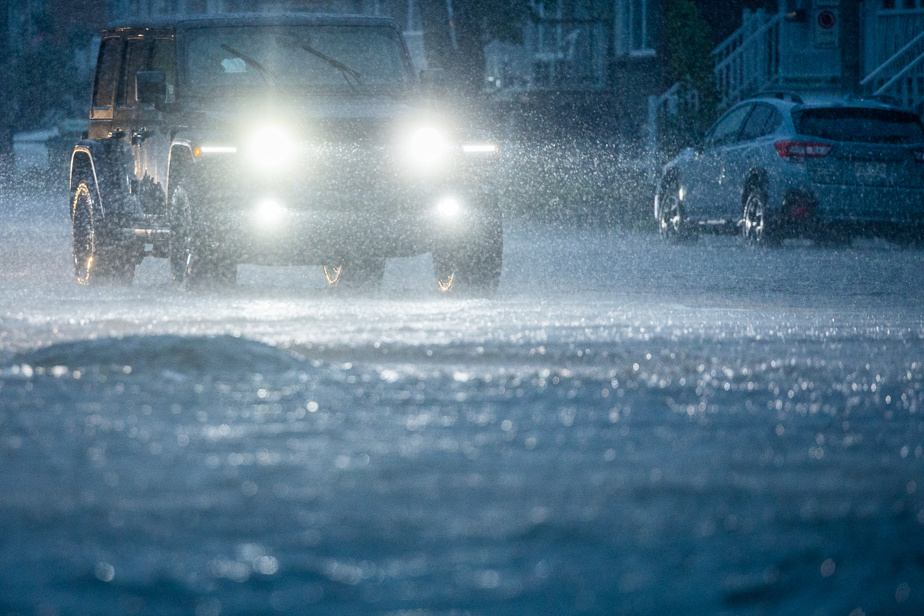About thirty roads remained closed on Monday, more than 72 hours after the tropical storm passed. DebbyHeavy rainfall, expected to become more frequent, has exposed the fragility of the road network, according to a transport planning expert.
A gradual return to normal
The road network is slowly recovering from the storm, which left record rainfall in its wake. On Monday, Quebec City was hoping to reopen Highway 13 by midweek. New pumps have been installed in the Dorval Tunnel, whose pumping system was damaged by sewer backups. Once drainage is complete, inspections will be conducted to ensure that no damage has been done to the structure. “We plan to reopen Highway 13 by Wednesday, ideally before if possible. It will depend on what we find below the water,” said Gilles Payer, spokesperson for the Ministry of Transport and Sustainable Mobility.

PHOTO DOMINICK GRAVEL, LA PRESSE ARCHIVES
At the height of the storm, “hundreds of roads” were affected, underlines the spokesperson for the Ministry of Transport and Sustainable Mobility, Gilles Payer.
More obstacles
Elsewhere, motorists will have to be patient. Some thirty secondary roads remain blocked for an indefinite period, most of them located in the Lanaudière, Mauricie and Laurentides regions. “There are a lot of roads that have reopened or partially reopened, but it’s a case-by-case basis,” explains Gilles Payer. “It’s impossible to predict.” He points out that at the height of the storm, “hundreds of roads were affected,” which explains the delays. In total, 807 homes were isolated by torrential rain, 347 people were evacuated and 144 roads were damaged, according to a report from the Ministry of Public Security presented Monday.
A fragile network
According to transportation planning expert Pierre Barrieau, the storm exposed the fragility of Quebec’s road network. When it was designed, extreme precipitation events only occurred “once every few decades.” With climate change, they are set to become more frequent—and intense. “The standards on which the road network was designed no longer hold up today,” says the man who is also a lecturer at the School of Urban Planning and Landscape Architecture at the Université de Montréal. Retention basins, floodplains, roadside ditches: measures are gradually being put in place to promote water capture. But the pace must be accelerated. “We are in the process of making the shift, but our infrastructure legacy will take decades to change,” says Mr. Barrieau, who is urgently calling on the various levels of government to increase funding for the resilience of the road network.

PHOTO CHARLES WILLIAM PELLETIER, ARCHIVES SPECIAL COLLABORATION
The municipalities manage most of the roads, with Quebec only taking care of highways and national or provincial roads.
Repairs expected
As with the Dorval Tunnel, all blocked roads will have to be inspected before they are reopened. “There are temporary repairs being done, permanent repairs that will have to be done later,” says Gilles Payer. At this stage, it is also possible that other roads will be closed to traffic. Indeed, record rainfall could lead to flash floods. “There are places that could cause more rockfalls,” says Gilles Payer, adding that the Ministry’s teams are particularly monitoring roads near waterways. It should be remembered that municipalities manage most of the roads, with Quebec only responsible for highways and national or provincial roads.
Sometimes invisible consequences
How does rain damage roads? Under the asphalt, road surfaces are made up of several layers of aggregates, such as sand, gravel and rocks. “When it rains hard, the sand goes away with the water, and all that’s left are the big rocks,” explains Pierre Barrieau. At that point, the road surface becomes unstable. “The asphalt is suspended with nothing underneath and all it takes is a truck to break it,” he continues. Often, this type of damage is not visible to the naked eye. “There are technologies that allow us to [le] see,” the expert notes.
